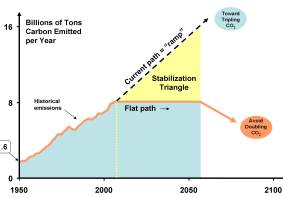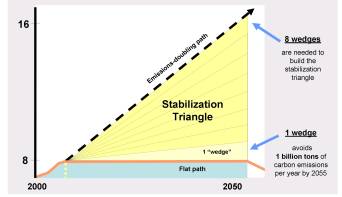|
from The Worldview Literacy Book copyright 2009 back to worldview theme #40 |
|
Discussion
The early environmental movement was informed by bio- logist
Barry Commoner's 1970 book The Closing Circle.
He argues that the environmental crisis fundamentally has two
dimensions: the activities of humans are disrupting natural cycles and
their economic accounting ignores certain real, difficult to measure,
costs. This latter problem
was first analyzed in 1950 in The Social Costs of Private Enterprise
by economist K.W. Kapp. Kapp
felt if the ignored costs of "environmental externalities"
were included in economic cost vs. benefit analyses,
sometimes "production may take place at total costs in
excess of total benefits." Today,
we describe externalities ignored by market-based pricing in various
ways: loss of natural capital biodiversity,
not valuing ecosystem services, not recognizing when ecological debts
are incurred or the "bads" that accompany "goods."
Generally fossil fuel based technologies have more environmental
impact and greater hidden costs than renewable energy based ones.
Their disruption of the carbon cycle is especially worrisome (see
Discussion, theme #23A).
In this regard, consider two ways of generating electricity at
centralized power plants: from burning coal or by utilizing solar
energy. As 2007 began, U.S.
power companies expected to bring online nearly 300 new (500 megawatt or
larger) coal fired plants by 2030.
China was building the equivalent of one every week!
Plans for solar are plagued by its comparatively high cost: $.16
and $.18 per kilowatt-hour (kwh) for electricity from photovoltaic and
concentrating solar power stations vs. $.05 per kwh from coal fired
power plants. Environmentalists
argue that the lower figure for coal ignores the following hidden costs. 1) Mining endangers human health—accidents annually kill thousands in China, black lung disease wastes
many more, etc. It scars the landscape—reclamation
is possible and sometimes promised but never returns the land to what it
was. 2) Water is polluted
by acid mine drainage from sulfur compounds leached from waste tailings. 3) Air is polluted by burning coal—2/3 of all U.S. atmospheric sulfur dioxide, 1/5 of all nitrogen oxides
emission, fifty metric tons/yr of mercury, and billions of tons
Figure
# 40a: Stabilization Triangles |
Discussion—continued of carbon dioxide—37% of global emissions.
If these costs and others were added in, electricity from coal
would cost more than solar, they argue!
A carbon tax is needed, they say.
There are many ways of reducing
global climate threatening greenhouse gas output.
Princeton's Carbon Mitigation Initiative (Figure #40a) has
pioneered the wedge concept. Each
wedge represents a reduction of twenty-five billion tons of carbon = 92.5
billion tons of CO2 emissions over fifty years. Implementing strategies that save eight wedges are needed.
Various ones can be designed around increased use of renewable energy,
reviving nuclear energy, carbon capture and storage, increasing energy
efficiency, reducing deforestation, and government actions that force
fossil fuel users to pay their true costs.
Besides encouraging markets to factor in environmental & social
costs, governments can promote environmental friendly technologies with
subsidies, tax credits and other incentives.
A 2007 study concluded if the
U.S. invested $420 billion over the next forty years in subsidizing
photovoltaic & concentrating solar, by 2050 these technologies could
economically (for $.09 per kwh) provide 69% of the United States'
electricity needs and 35% of its total energy.
U.S. wind farms have benefited from a $.019 per kwh production tax
credit—making wind generated electricity competitive with that produced
from coal. But Congress threatening to repeal this has slowed the growth
of such renewable energy. Market
uncertainty stifling investment can be minimized if governments provide
guaranteed long-term subsidies. Thus carbon taxes—say $40/ton of carbon
dioxide emitted—may be a better way to curb emissions than cap and trade
schemes, given the latter's price volatility.
Finally, instead of using gross
national product (GNP) to gauge economic well being, those who like
"Environmental Economics" and "Sustainability" (theme
#23A) want government planners to begin using the green
national product. This index
of sustainable economic welfare is obtained by including certain hidden
costs and making other adjustments to GNP.
It factors in depletion of natural resources and any long-term
environmental damage associated with economic activities.
|
|
Figure #40b: Examples
of carbon dioxide or greenhouse gas equivalent emissions 1)
for average American in lbs
CO2/ yr person: driving
an SUV: 15, 316 typical
electricity use:
8,145 typical
meat-based diet adds 3000 more than non-meat diet typical
amount of trash (1130 lbs) creates 1060 2) round trip airplane flight between NYC and LA 2,580 lbs CO2/ person flight
source
is U.S. EPA for all— except meat diet where source is Univ. of Chicago USA
per capita carbon footprint = twenty metric tons = 44,090 lbs CO2/ yr person
|

